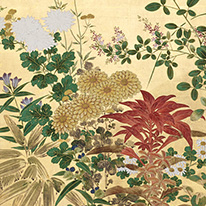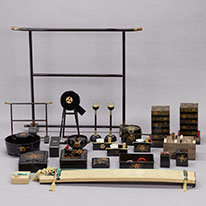Past Exhibitions
- Feature Exhibition; Hidden Treasures from a Merchant’s Storehouse:
The Hiromi Collection, a Legacy of Elegant Living
Part V: Weddings—Forging Favorable Family Networks - February 3, 2018 - March 18, 2018
The Hiromi family is an old merchant family in the city of Kaizuka, in Osaka (not far from Kansai Airport). Their family business, established in 1835, was a shipping brokerage (kaisen don'ya) for the rice trade. Thereafter, they added a variety of other divisions including fertilizer, stock investment, and bank management, which not only grew the family assets but also contributed to the development of modern industry in the region. Their spacious estate includes a 34 meter-wide machiya, a tea house, and four earthen storehouses (kura) filled with a vast treasure trove of artworks—painting and calligraphy, tea utensils, furnishings, and other luxurious objects. These long hidden treasures, including works by Itō Jakuchū, Shiba Kōkan, Shibata Zeshin, and others, have been discovered in recent years and donated to the Kyoto National Museum for preservation, study, and exhibition to the public.
Part V: Weddings—Forging Favorable Family Networks
For prosperous merchant families, weddings were important opportunities to deepen and enrich relationships that could be beneficial to family businesses. The women who married into the Hiromi household served as bridges between their own blood relatives and their new family. At their weddings, they were accordingly feted with all the luxury kimonos they would need for a lifetime, as well as full sets of lacquered furnishings decorated with elaborate gold makie designs.
The Hiromis preserved bridal trousseaus from family marriages in the Meiji (1868–1912) and the Taishō (1912–1926) periods. These celebrations at two different points in history tell us of the dramatic changes that Japan was undergoing at the time.
Regardless of the era, beautiful artworks were always an integral part of important Hiromi events. The backdrop for a Taishō period wedding photograph—with the bride and groom posing nervously—is the family's pair of golden folding screens Flowers and Plants of the Four Seasons by renowned Edo period artist Ōoka Shunboku (1680–1763).













